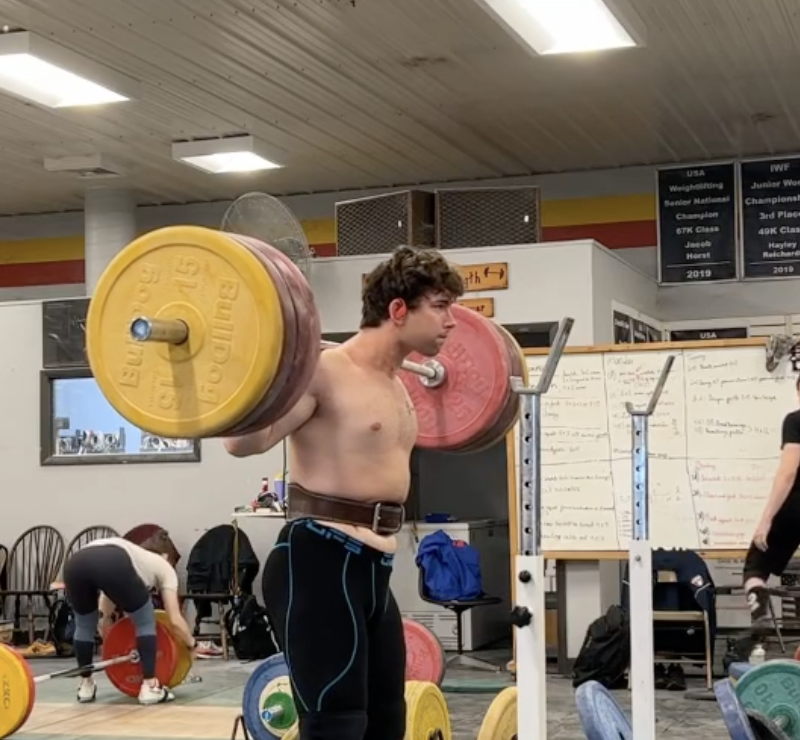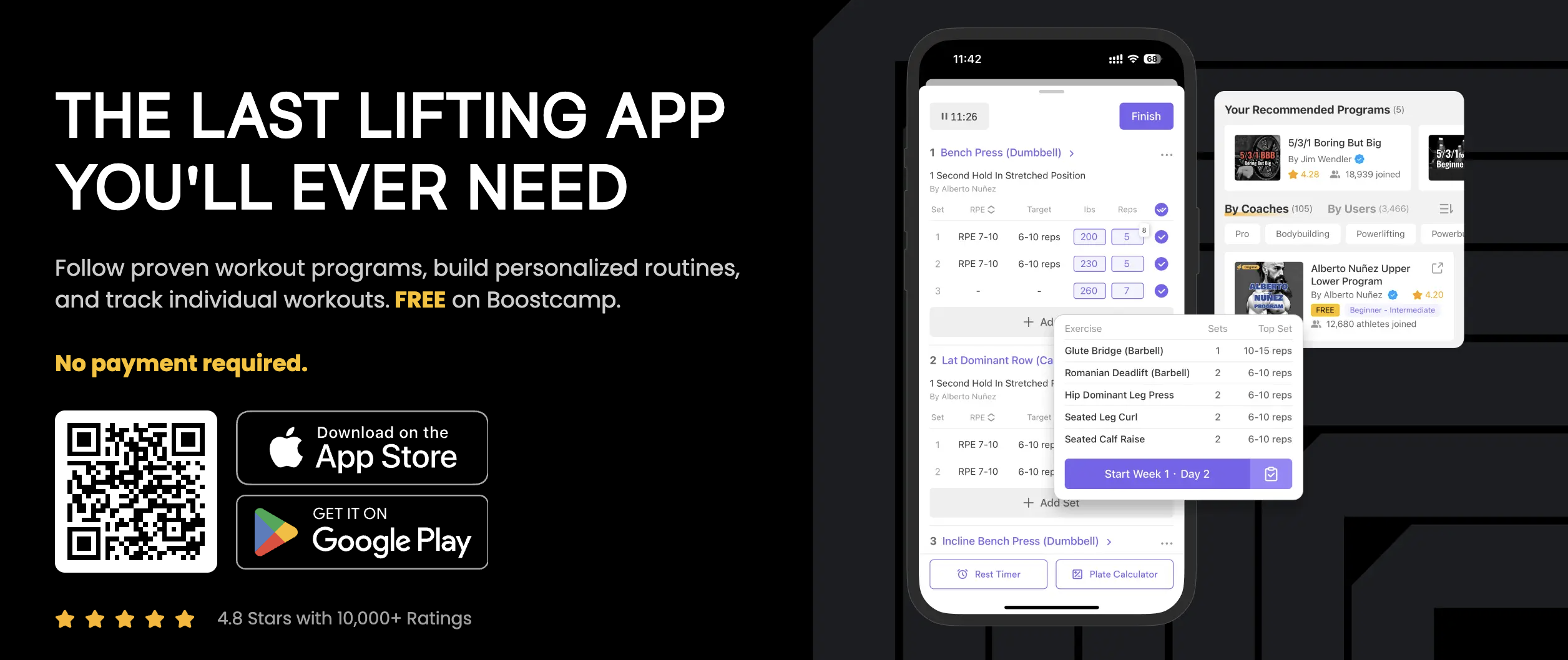How Long Should You Bulk? A Practical Guide
Written by The Boostcamp Editors
A Guide to Bulking for Optimal Muscle Growth, Rather Than Just Putting on Sheer Size
Are you tired of hitting a plateau in your muscle-building journey? Not getting any bigger or stronger? Maybe it's time to consider bulking and focusing on building muscle and strength. But how long should you bulk for? Our team at Boostcamp is going to break down everything you need to know about bulking, from understanding the concept to steps for initiating the process. Something to also discuss is the transition phase from bulking to cutting, or maintaining, and what dietary and training routine modifications are necessary during each phase. Additionally, we'll provide a comparative analysis of bulking and cutting, including their pros and cons. We also will discuss how long you should bulk before starting to cut, as well as whether it's possible to bulk and cut simultaneously. Get ready to take your muscle growth game up a notch!
Let's dive in.
Understanding the Concept of Bulking

Bulking is a fundamental concept in bodybuilding, as well as powerlifting, as it is aimed at promoting muscle and strength gain through a calorie surplus. It plays a crucial role for bodybuilders looking to increase muscle mass and improve their overall physique. During the bulking phase, the primary focus is on increasing body weight and muscle size. The goal is to create a caloric surplus, ensuring optimal conditions for muscle growth. This requires a combination of resistance training and proper nutrition, with an emphasis on consuming more calories than needed. While some individuals opt for a "dirty bulk," consuming excess calories from any food, including junk food. Others prefer a "clean bulk" with nutrient-dense foods like chicken breast, sweet potatoes, and dark leafy greens, with the goal of minimal fat gain. By following a well-planned bulking diet and maintaining an adequate daily protein intake, lifters can achieve the best results in terms of muscle building and overall body size.
Significance of Bulking for Muscle Growth
Bulking plays a significant role in muscle growth for several reasons. Firstly, it provides the necessary calories and nutrients required to support the growth and repair of muscles. By consuming a surplus of calories, the body is in a state of anabolism, which promotes muscle protein synthesis. This leads to increased muscle mass, strength, and improved body composition.
Moreover, bulking enables individuals to achieve their desired physique and muscle hypertrophy. It allows lifters to maximize muscle gains while minimizing fat gain. This is crucial for those looking to build muscle while minimizing excess body fat. A proper bulking diet includes a variety of foods such as chicken breast, sweet potatoes, leafy greens, legumes, and healthy fats like olive oil.
In conclusion, bulking is a vital phase for muscle growth and strength. By following a well-structured bulking program and consuming the right number of calories and macronutrients, individuals can optimize their muscle building efforts and achieve the best results. So, take the time to plan your bulking phase carefully and enjoy the benefits it has to offer, including putting on as much muscle mass as possible.
How to Start a Bulk
To initiate the bulking process, start by assessing your body composition and body weight to determine your starting point. It's important to calculate your daily caloric intake and set a calorie surplus for bulking. This will ensure you consume enough calories to support muscle growth. It's also crucial to create a structured resistance training program that stimulates muscle growth through progressive overload and proper form.
Additionally, focus on consuming nutrient-dense foods that provide adequate protein, carbs, and fats to fuel your workouts and support muscle recovery. Regularly monitor your progress and make adjustments to your bulking plan as needed. By following these steps, you'll be on your way to successfully initiating the bulking process for optimal muscle gains. Within your bulking program, remember to progressively overload by upping the weights, lessening the rest period, or increasing the reps. This will help challenge your muscles and promote further growth.
Diet Recommendations for Effective Bulking
To ensure effective bulking, it is crucial to focus on your diet. One of the key recommendations is to consume a calorie surplus by increasing your daily calorie intake. This provides the necessary energy for muscle growth. Prioritizing protein intake is also essential as it supports muscle repair and growth. Complex carbohydrates should be included in your meals as they provide sustained energy during workouts. In addition, incorporating healthy fats, such as those found in olive oil, promotes hormone production and overall health. Staying hydrated and timing your nutrient intake properly are vital for optimal muscle recovery, and another way to get the proper nutrient intake is through supplements. You can use things like creatine to help put on size. By following these diet recommendations, you can maximize your gains during the bulking phase.
The Transition From Bulking to Cutting

Transitioning from a bulking phase to a cutting phase involves making adjustments to your dietary and exercise routine in order to drop that body fat, so your abs can start to show a little bit. This transition allows your body to shift from a calorie surplus to a calorie deficit, which is crucial for fat loss. It's important to gradually decrease your calorie intake and increase cardio exercises to create a calorie deficit. The goal during this transition phase is to maintain muscle mass while reducing body fat, ultimately achieving a lean and defined physique after the bulking phase.
To do so, you can focus on consuming nutrient-dense foods like chicken breast, sweet potatoes, leafy greens, legumes, tofu, and broccoli, while reducing the intake of fast food and junk food. Remember to adjust your daily protein intake, as well as your number of calories and macros, to support muscle building and optimize your cutting cycle. By following a well-balanced diet and incorporating exercise, you can achieve the best results during the transition from bulking to cutting.
To determine when to start cutting, assess your progress and goals. Consider factors like body fat percentage and overall body composition. When you've reached your desired muscle gain and are ready to focus on losing the extra fat, seek professional guidance if needed. Listen to your body and make an informed decision based on your individual needs.
Bulking vs. Cutting: A Comparative Analysis
Bulking and cutting are two distinct phases in a bodybuilder's journey towards achieving their desired body composition. The primary focus of bulking is to maximize muscle growth, whereas cutting aims for fat loss. During the bulking phase, individuals consume a calorie surplus to provide their bodies with the energy needed for muscle building. On the other hand, cutting involves creating a calorie deficit to promote fat loss and reveal the muscle definition gained during the bulking phase.
While bulking allows for increased muscle size and strength gains, it may also lead to some fat gain. On the contrary, cutting requires careful management of calorie intake to avoid muscle loss while shedding excess body fat. Both phases are essential for bodybuilders to achieve their desired physique. It's important to note that the duration of each phase can vary depending on individual goals and body composition. Coming back to maintenance calories in between these bulking cycles will give your body a chance to regulate itself by re-distributing some of the fat you’ve gained or perhaps you might even lose some fat and retain muscle as you go back to maintenance.
To support their goals during the different phases, bodybuilders often follow specific diets. A bulking diet typically includes a higher calorie intake, focusing on nutrient-dense foods such as chicken breast, sweet potatoes, leafy greens, and healthy fats like olive oil. Conversely, a cutting diet involves reducing calories while maintaining adequate protein intake to preserve muscle mass. This could include foods like lean proteins, leafy greens, legumes, cruciferous vegetables like broccoli and cauliflower, and fruits such as apples, oranges, bananas, grapefruit, and all types of berries. Adding pineapple to the list of fruits provides a delicious and nutritious option for bodybuilders looking to vary their fruit intake.
By understanding the key differences between bulking and cutting, bodybuilders can make informed decisions about their training and dietary choices to achieve their desired body composition. It's essential to find the right balance between the two phases to ensure optimal results and minimize any potential drawbacks.
Pros and Cons of Bulking
When it comes to bulking, there are several pros and cons to consider. On the positive side, bulking promotes muscle growth, increases strength, and improves overall body composition. It also allows for greater flexibility in food choices, which can be a motivating factor for many individuals. However, there are some cons to be aware of as well. Bulking may result in some fat gain and requires strict dietary discipline to maintain balance. Another challenge is determining the optimal length of a bulking phase, as it varies depending on individual goals and body size. Additionally, bulking without proper monitoring can lead to excessive weight gain and potential health issues. It's important to weigh these pros and cons and make informed decisions when embarking on a bulking journey.
Pros and Cons of Cutting
Cutting, one of the phases in bodybuilding, has its own set of pros and cons. One of the main benefits of cutting is that it helps reduce body fat and improve muscle definition. By cutting, individuals can achieve a leaner physique that showcases their hard-earned muscle mass. However, it's important to note that cutting for an extended period can lead to muscle loss. This is why finding a balance between cutting and bulking phases is crucial. By incorporating both phases into your fitness journey, you can optimize your results and achieve the desired body composition. Remember, the key to successful cutting lies in maintaining muscle mass while shedding excess fat.
How to Achieve Optimal Results from Bulking and Cutting

Properly planning and tracking your nutrition is crucial for achieving optimal results from bulking and cutting. By understanding and optimizing your macros (macronutrients such as protein, carbohydrates, and fats), you can ensure that your body gets the right nutrients to support muscle growth during bulking and fat loss during cutting. Tracking your daily intake and making adjustments based on your body's response is key to maximizing your progress.
In addition to nutrition, resistance training is essential for building and maintaining muscle mass. Incorporating exercises that target different muscle groups and progressively increasing the intensity over time can help stimulate muscle growth. This includes lifting weights, performing compound movements like squats and deadlifts, and incorporating variations such as drop sets and supersets.
Another important aspect is gradually adjusting your calorie intake. During the bulking phase, you should gradually increase your calorie intake to provide your body with sufficient energy for muscle growth. Conversely, during the cutting phase, gradually decreasing calorie intake can help create a calorie deficit and facilitate fat loss.
By following these strategies and staying consistent with your nutrition and training, you can achieve optimal results from both bulking and cutting phases. Remember, everyone's body is unique, so it's important to listen to your body and make adjustments as needed to suit your goals and preferences.
Common Misconceptions About Bulking and Cutting
There are a few common misconceptions surrounding the concepts of bulking and cutting. One myth is that bulking always leads to excessive fat gain. However, with a calculated approach, it's possible to minimize fat gain while maximizing muscle growth. Another misconception is that cutting means drastically reducing calorie intake. In reality, cutting involves a slight calorie deficit to promote fat loss while preserving muscle mass. The easiest way to determine how many calories you need to be eating to maintain your current weight is to use an online TDEE calculator like this one. It's important to have a balanced approach and not resort to extreme measures. By following a well-planned diet and exercise routine, you can achieve the desired results without compromising your overall health and well-being.
How Long Should One Bulk Before Starting to Cut?
The ideal duration for a bulking cycle before transitioning to cutting can vary depending on individual goals and factors. Experts typically recommend a bulking cycle of 8-12 weeks to see noticeable muscle gain. However, it's important not to prolong the bulking cycle excessively, as it may lead to excessive fat gain.
What are the Factors Determining the Bulking Duration?
Factors such as initial body composition, activity level, and starting point play a crucial role in determining the length of a bulking phase. Individuals with higher body fat may opt for shorter cycles, while muscle growth rates also vary. Regular progress assessment helps adjust the duration accordingly.
Is it Possible to Bulk and Cut Simultaneously?
Achieving simultaneous bulking and cutting, also known as body recomposition, is challenging but not impossible. This approach focuses on gradually changing body composition through careful tracking of calories, macronutrients, and resistance training.
Conclusion
In conclusion, the duration of your bulk depends on various factors, including your goals, body composition, and personal preferences. It's important to listen to your body and make adjustments as needed. Remember, bulking is a gradual process that requires patience and consistency. Additionally, it's crucial to understand that bulking and cutting are not binary phases but rather a continuum. The ultimate goal is to achieve optimal results by finding the right balance between muscle gain and fat loss. Seek guidance from a fitness professional or nutritionist to develop a personalized plan that suits your needs. Stay committed, stay disciplined, and enjoy the journey towards a stronger and healthier you.
Be sure to follow Boostcamp on Instagram and subscribe on YouTube!

Images courtesy of Ivan Escott (@depth.vader)

